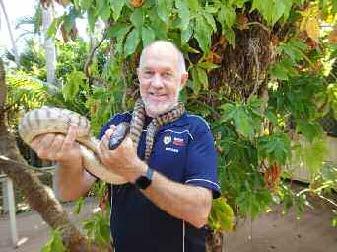2019 - THE SNAKE MAN
Meet George, a very handsome, intelligent and well-mannered Black Headed Python. He’s a movie star from Bran Nue Dae, only 10 years old and a friend of Chris Mitchell, known in Broome as the “snake man”. Chris volunteers for the Broome Native Animal Rescue and has a license to be a snake keeper and an education license to help people better understand snakes and other wildlife. Technology has definitely made his life easier identifying and catching snakes, as he can give a person an immediate response about a snake and whether he needs to go to the rescue. It also stops the unnecessary killing of snakes as they are a protected species. Unfortunately, people are paranoid about snakes. Chris says, “Snakes get a pretty bad rap but they are really interesting creatures”.
What sort of snakes do we get around Broome?
Most snakes we get around Broome are mostly pythons and harmless ‘venomous‘ species including species like the Whip Snakes and Moon Snakes. Even though both species are from the venomous side of the snake family, with the moon snake it is like being bitten by an ant. There are no medical consequences. Same with the Whip Snake. He might cause a bit of pain, but the bite is innocuous. They are not harmful to children, pets or adults.
We also have the Western Brown Snake called Gwardar and the King Brown, commonly called Mulga – which is a member of the Black Snake family. If bitten the immediate treatment is to put a pressure immobilisation bandage on the affected limb and seek medical help. Correct pressure and immobilisation of the limb is important and will save lives.
It’s not that important to identify the type of snake as the hospital will undertake tests to identify the type of venom. From records it can be seen that fatalities from snake bite in Australia are from the Western and Eastern Brown, Dugite, Death Adder and Tiger Snake. The King Brown doesn’t even get a mention nor does the Red Bellied Black. If bitten by a Black snake they can make you pretty sick that is why the correct snake bite treatment is essential.
If I get bitten what do I do?
Firstly, control your fear. Don’t run around madly. Ignore the snake – you don’t have to take the snake to the hospital. I have actually been in hospital where the snake got out in the Emergency Department! That was pretty funny, probably not so at the time.
Next is, pressure and immobilisation. You can use anything as a bandage: a t-shirt or sheet. We actually promote a kit to help raise funds for Native Animal Rescue Broome. Most people get bitten on the hand or ankle. If the hand was bitten, you would firmly wrap a pressure bandage from below the elbow down the forearm and then another from the elbow up to the shoulder. This is to slow down the venom moving through the lymphatic system. Many people think the venom flows into your blood stream, but it’s the lymphatic system which carries the venom. Venomous snakes in Australia have about 4 mm long fangs. Our snakes are not long fanged – a definite plus for us.
What happens when a snake bites you?
A snake strikes in three ways. They strike and just ‘’kiss’’ you, not even opening their mouth, like a warning that you are in their space. The second one is an actual bite, which is why boots and long trousers are recommended. The third strike is a full-blown envenomation and that snake is pretty annoyed. This happens when the snake feels threatened and is trying to survive. Obviously, envenomation is the last thing you want to happen.
With a single bite, most of which are dry bites, and a pressure bandage applied you have at least 24 hours to get to medical treatment. With a dry bite you will probably need no anti venom. Your body can actually absorb that small amount of venom over time. Without a pressure bandage symptoms develop much quicker.
No one in Australia should die from snake bite if you put a pressure bandage on and completely immobilise the limb straight away. A bite is normally not painful, so sometimes you might not even notice you have been bitten. If in doubt treat as though you have been bitten. Otherwise left untreated you will probably experience the symptoms of snake bite and could be in a life-threatening situation.
Sometimes I ask myself, “Why am I catching this snake?” Most of the time I’m removing it from an area where it is in danger, usually from around houses and I take them out into the bush where they will be safe. Sometimes I have to even remove blue tongue lizards.
I walk through the bush a lot and never see snakes. How come?
During the cooler, dry months snakes usually find a nice place to curl up and just chill out. They shut down their digestive system for about three to four months and remain semi dormant. If it is a nice warm day, they might sun themselves to warm up. So, you don’t see them around much.
Snakes react with fear, flight or freeze. If they react with fear, they may have a go at you. Flight; they’ll move away or if they freeze they’ll remain perfectly still.
Death Adders are classics; their camouflage is awesome, you can step right next to one and you will not know it’s there. A King Brown will usually just cruise away, while a Western Brown has attitude. I love catching the Westerns: you have to stay completely focused as they move very quickly and more than likely have a go at you.
It is amazing what you might find in your garden and the wet season is when they start moving about. Moon Snakes love living in the mulch.
What about their sex life?
When it is mating season some of the males will fight (not to the death) pushing their bodies against each other. This is often seen in King Browns. The winner gets the female, and she can mate with multiple males. With pythons eggs are laid and the female will wrap themselves around the nest and incubate them for a couple of months. She won’t eat but will seek out water. The day of hatching the female is gone. She is hungry and the young ones can fend for themselves. With the venomous snakes they lay their eggs in secluded spots and leave them to hatch themselves.
There is usually between 10 – 30 eggs depending on the type of snake. Most snakes are egg layers, except the Tiger and Death Adder which give birth to live young. The hatchlings stay around the egg cluster for a couple of weeks and then have their first shedding or ‘slothing’. After that they are ready to go out into the world. This is when the stronger ones will eat the weaker siblings. In captivity, we separate the babies and hand feed them all.
What is your favourite snake?
Hard to say as they all have different characteristics and personalities, though I suppose I like the pythons and the Black Headed python especially. It is just a beautiful animal. I have a Stimpsons Python which sits around my neck pulsates and massages, I have had her for 10 years and she is really placid.
What sort of injuries do the snakes come in with?
I have snakes in rehabilitation in various stages of recovery before they are released back into the wild. They are here because of dog attacks, run over by a car or hit by a shovel. Sometimes they come in with deep gashes that do not seem to have damaged any major organs.
It is quite interesting that when you are caring for a highly venomous snake they seem to know you are trying to help them and they just lie there. We do put a tube on their head just to be on the safe side. We had an Olive python that came in and a third of its body had been debrided– meaning that its skin had been ripped off – it may have been wrapped around an exhaust pipe. The skin eventually grew back with a few white patches.
You run courses?
Yes, we like to educate people and especially children. One question we ask is that if you stood near a snake and look at the size of the snake compared to yourself who is going to be more frightened? We are just this huge object and the snake is frightened of us. Most of their predators come from above. They will either get out of your way or stay still. Most snakes do have a personality. Some species will rear up and flare their neck to make itself look more ferocious. On our courses we use snakes that are reactive but not psycho in order to build confidence in our participants. We work slowly, methodically and not rush in our snake handling or we may stress the participants and the snakes.
I sometimes come across sea snakes on the beach. What should I do? Sea snakes are not agile on land, but they are highly venomous. Laying for a couple of hours on the beach in the hot sun is definitely not good for them. Ring us and we will see if it will go back in the water, otherwise we will bring it into care and check it over. Usually, it is exhaustion or sometimes a swim bladder problems. We have contacts all over Australia with sea snakes and the Perth Zoo who assist us and we have a close association with Broome Vets.
Give me some facts about snakes.
· Snakes do not chase you.
· They do not crush their prey – they asphyxiate them
· They only kill what they want to eat
· They swallow their victim whole
· Their sense of smell is better than a greyhound
· Their tongue is their main sensory organ
· They are not blind, they do have reasonable eyesight Life span is about 15 to 25 years or more – dependent on species
· Males have two penises – called hemipenes
What other animals do you rescue?
Native Animal Rescue Broome really cares for any wildlife, since Chelonia closed we have taken on turtles and sea snakes and hoping to get a facility through the Department of Parks and Wildlife for them. Kimberley Wildlife Rescue cares for bats, kangaroos, wallabies and birds. Our volunteers are multi-talented and we do everything.
Chris seems pretty casual about snakes. I feel a bit more at ease now. We have an open house in Broome on the edge of some bush, so we get a few travelling through on their way somewhere. Now I know to simply stand still and give them the right of way and definitely not panic!

